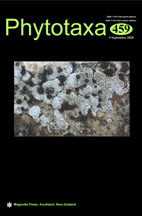Abstract
This paper presents a re-evaluation of the taxonomic identity of Sciaphila major described from Sarawak, Borneo, Malaysia which has been considered conspecific with S. secundiflora. We revealed that S. major is clearly distinguishable from S. secundiflora s.s. by the arrangement of flowers on rachis (spirally and subdensely arranged vs. secundly and laxly arranged), rachis length in a fully developed inflorescence [(2–)3–6(–7) cm vs. 6–19 cm], tepal length of male flowers (2–2.3 mm vs. 3–4 mm) and the number of perianth segments (more than 6 vs. 6). By spirally-arranged and white flowers, S. major is most similar to S. alba, but is distinguishable by plant height (15–25 cm vs. 25–35 cm in S. alba), rachis length in a fully developed inflorescence [(2–)3–6(–7) cm vs. 8–14 cm)], the number of flowers (usually less than 20 vs. usually more than 20), the arrangement of flowers on rachis (subdensely arranged vs. laxly arranged), the number of male perianth segments (usually more than 6 vs. usually 6) and the condition of floral disc (flat vs. bowl-shaped). We also provide an updated key to the species of Sciaphila distributed in Borneo.

